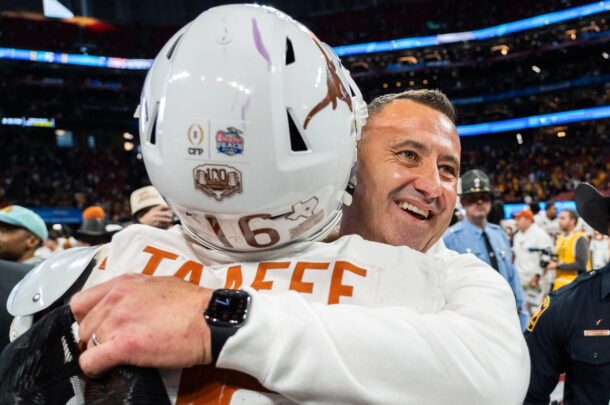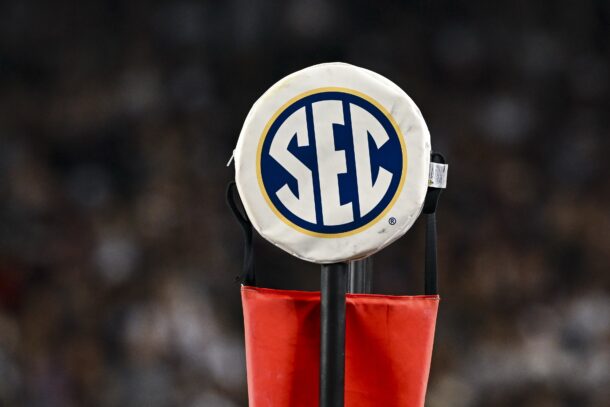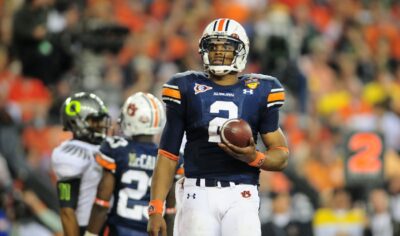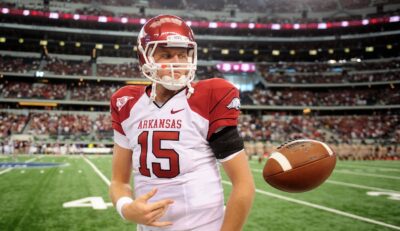
What do these 4 Playoff teams have in common? A winning transfer portal approach
During Notre Dame’s victory against Georgia in the Sugar Bowl, the ESPN broadcast crew shared Marcus Freeman’s approach to the transfer portal.
“We’re never gonna major in the portal, just minor in it.”
Roll your eyes if you will at the borderline dad joke to describe a personnel philosophy. They brought that up during a quarterfinal game in which all 23 of Notre Dame’s points came from transfer portal guys, most notably former Duke quarterback Riley Leonard. But that’s not necessarily the byproduct of a portal-heavy approach. As On3’s Tyler Horka pointed out, 7 of Notre Dame’s 8 portal players came up with at least 1 crucial play during what was arguably the program’s biggest win of the 21st century. That included Jayden Harrison (Marshall) returning the 2nd-half kickoff back for a touchdown to make it a 3-score game.
At Notre Dame, where academic restrictions limit the overextending of portal offers, the Irish will likely always be a team that loses more transfers than it gains. In other words, hitting on those select portal additions is magnified.
Therein lies the common denominator with this remaining Playoff field.
Notre Dame, Ohio State, Texas and Penn State are all at this place thanks in part to a selective, but smart approach to the transfer portal.
Transfers won’t be the foundation of any of those programs. In many cases, they’re the final pieces to championship puzzles.
Texas had a quarterfinal victory that, like Notre Dame’s, saw transfers emerge as heroes. Matthew Golden’s (Houston) 4th-and-13 score in overtime was arguably the most important Texas touchdown since Vince Young got the edge against USC 19 years ago. Of course, that wouldn’t have mattered quite as much if Texas couldn’t close Arizona State out in the 2nd overtime, but it did thanks to Andrew Mukuba’s (Clemson) game-sealing interception.
Texas returned a wealth of experience from last year’s Playoff team, including former Ohio State transfer Quinn Ewers. Yet even after it lost 25 players to the portal, it addressed some key areas with the 12 transfers it brought in, also including starting receiver Isaiah Bond (Alabama) and defensive lineman Bill Norton (Arizona), who had the monumental 4th-down stop late against Texas A&M.
You’d never know that Texas was minus-13 in the portal during the 2024 cycle, or that Notre Dame was minus-9. Ohio State was actually minus-18 in the portal, but it’s safe to say the 7 transfer additions outweighed the 25 players that it lost.
Caleb Downs left Alabama and addressed a pivotal area of need for Ohio State in the secondary. All he did was continue the blistering start to his career by becoming a unanimous All-American safety for the nation’s No. 1 defense. That was the only defensive area that Ohio State addressed in the portal. On offense, the Buckeyes added former preseason All-American running back Quinshon Judkins (Ole Miss) and quarterback Will Howard (Kansas State), both of whom will have a major say in whether they win a national title as the field’s new favorites. The Buckeyes also got their quarterback of the future, Julian Sayin (Alabama), after Nick Saban retired and the 30-day transfer window opened.
Seven guys. That’s it.
That’s 1 more than Penn State, though the Nittany Lions haven’t quite packed the same punch with their additions. They did get a big lift from A.J. Harris (Georgia), who became an All-Big Ten corner. Alongside Jalen Kimber, both Penn State starting outside corners began their careers at Georgia. They both played significant roles for a defense that ranks No. 7 in FBS in scoring. Go figure that ranks last among the remaining Playoff field.
I suppose that’s another common denominator with these remaining Playoff teams. Ohio State (No. 1), Notre Dame (No. 2), Texas (No. 4) and Penn State (No. 7) are all elite defenses, thanks in part to those plug-and-play transfer additions.
They all still recruit the high school level at an elite rate, which sets up the inevitable scenario that a logjam of blue-chip recruits leave after 1-3 years because they can’t get on the field. Hence, that guaranteed quantitative loss in the portal.
In the last 3 transfer cycles since transfer portal restrictions loosened, here’s the year-by-year breakdown of transfers gained vs. transfers lost among those 4 Playoff programs:
- Notre Dame
- 2022: -10
- 2023: -5
- 2024: -9
- Ohio State
- 2022: -16
- 2023: -1
- 2024: -18
- Penn State
- 2022: -13
- 2023: -5
- 2024: -7
- Texas
- 2022: -16
- 2023: -14
- 2024: -13
A negative number is all but guaranteed at established places like that. The only class in that group who had double-digit incoming transfers was Texas’ 2024 class, which brought in 12, though that group also lost 25 players in the portal.
That’s the other takeaway. Losing 20-to-25 players might be spun as some sign that a program is collapsing. A number like that usually needs context. If there are 10-to-15 starters in a group of 25 that are leaving, that’s one thing. But at places like Texas or Ohio State, who returned a wealth of production, a big export number is more indicative of a program that’s forcing talented players to seek other options because guys can’t see the field.
But hey, context doesn’t always fit the narrative.
What all 4 semifinal teams showed is that you don’t need to ignore the portal like Dabo Swinney (he has since reformed), nor should you need to use the portal as the entire foundation like “Portal King” Lane Kiffin (26 additions) or Mike Norvell (17 additions). At least not if you want to compete for championships.
In an ideal world, contending teams would follow the lead of these 4. They’d address a few key areas of need, be content with more portal exports than imports and hope that their evaluation leads to instant-impact guys playing pivotal roles for championship teams.
By now, that formula shouldn’t be a major revelation.
Connor O'Gara is the senior national columnist for Saturday Down South. He's a member of the Football Writers Association of America. After spending his entire life living in B1G country, he moved to the South in 2015.







